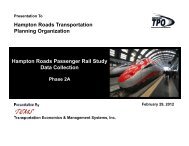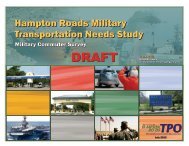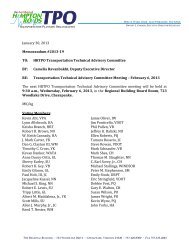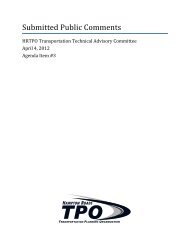Hampton Roads Regional Bridge Study
Hampton Roads Regional Bridge Study
Hampton Roads Regional Bridge Study
Create successful ePaper yourself
Turn your PDF publications into a flip-book with our unique Google optimized e-Paper software.
INTRODUCTION 1<br />
INTRODUCTION<br />
<strong>Bridge</strong>s are a prominent part of the <strong>Hampton</strong> <strong>Roads</strong> landscape. Major<br />
spans such as the Coleman <strong>Bridge</strong>, James River <strong>Bridge</strong>, and High Rise<br />
<strong>Bridge</strong> provide a connection between distinct areas of the region. <strong>Bridge</strong>s<br />
on the Interstate system create a limited access network designed to<br />
improve mobility into and throughout the region. Other bridges provide a<br />
grade separation that allows traffic to cross intersections without stopping.<br />
And smaller structures such as culverts span the myriad of creeks,<br />
swamps, and waterways in our region.<br />
As bridges both in <strong>Hampton</strong> <strong>Roads</strong> and throughout the country age,<br />
maintaining these structures has been difficult. The costs of constructing<br />
bridges can be four to six times higher than typical urban roadway<br />
reconstruction costs according to VDOT planning level estimates. This<br />
additional cost has contributed to funding not keeping up with bridge<br />
maintenance needs. As of 2009, FHWA estimated 1 that $71 billion was<br />
needed to address the national backlog of nearly 150,000 deficient<br />
bridges.<br />
Because of the importance of bridges to the regional transportation system<br />
and concerns about the condition and funding of bridges, the <strong>Hampton</strong><br />
<strong>Roads</strong> Transportation Planning Organization in 2007 began analyzing<br />
factors impacting regional bridges. The <strong>Hampton</strong> <strong>Roads</strong> <strong>Regional</strong> <strong>Bridge</strong><br />
<strong>Study</strong> for the first time provided a regional analysis of bridge topics such<br />
as bridge inspections and ratings, deficient bridges, bridge funding and<br />
projects, and the impacts that the closure of major bridges would have on<br />
<strong>Hampton</strong> <strong>Roads</strong> travel patterns.<br />
This 2012 update of the <strong>Hampton</strong> <strong>Roads</strong> <strong>Regional</strong> <strong>Bridge</strong> <strong>Study</strong> builds on<br />
the previous study. Sections in this update include:<br />
<br />
<strong>Bridge</strong> Definitions – This section includes the definition of a<br />
bridge used in this study and details the different types of bridges.<br />
1 FHWA, Computation of Apportionment of the Highway <strong>Bridge</strong> Program Funds for Fiscal Year 2009.<br />
Accessed from http://www.fhwa.dot.gov/safetealu/revfy09comptables.pdf.<br />
Virginia Port Authority<br />
JAMES RIVER BRIDGE VDOT<br />
<strong>Regional</strong> <strong>Bridge</strong> Summary – This section includes summaries of<br />
bridges in <strong>Hampton</strong> <strong>Roads</strong> by ownership, type of service,<br />
length/area, and year built.<br />
<strong>Bridge</strong> Inspections and Ratings – Based on detailed inspections,<br />
bridge inspectors assign ratings to various components of each<br />
bridge. This section describes these components and how each<br />
of them is rated.<br />
Deficient <strong>Bridge</strong>s – This section describes how bridges become<br />
classified as structurally deficient or functionally obsolete and<br />
includes a summary of those bridges in <strong>Hampton</strong> <strong>Roads</strong> that are<br />
deficient. Details are also included on bridges with posted<br />
weight limits.<br />
Fracture and Scour Critical <strong>Bridge</strong>s – This section defines fracture<br />
critical and scour critical bridges, and details those bridges in<br />
<strong>Hampton</strong> <strong>Roads</strong> that are classified as fracture or scour critical.<br />
Sufficiency Ratings – Sufficiency ratings are numerical<br />
assessments given to each bridge based on a variety of factors.<br />
This section describes sufficiency ratings and provides a summary<br />
of <strong>Hampton</strong> <strong>Roads</strong> bridges with low sufficiency ratings.<br />
HAMPTON James City/Williamsburg/York ROADS REGIONAL Transportation BRIDGE STUDY <strong>Study</strong>












